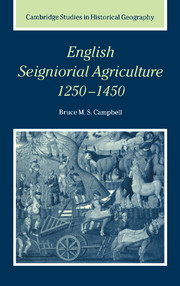Book contents
- Frontmatter
- Contents
- List of figures
- List of tables
- Preface and acknowledgements
- Abbreviations
- Weights, measures, values, and boundaries
- 1 Introduction: agriculture and the late-medieval English economy
- 2 Sources, databases, and typologies
- 3 The scale and composition of the seigniorial sector
- 4 Seigniorial pastoral production
- 5 Seigniorial arable production
- 6 Crop specialisation and cropping systems
- 7 Arable productivity
- 8 Grain output and population: a conundrum
- 9 Adapting to change: English seigniorial agriculture 1250–1450
- Appendix 1 Demesne-level classification of husbandry types
- Appendix 2 Demesnes represented in the Norfolk accounts database
- Appendix 3 Demesnes represented in the FTC accounts databases
- Consolidated bibliography
- Index
- Cambridge Studies in Historical Geography
6 - Crop specialisation and cropping systems
Published online by Cambridge University Press: 20 October 2009
- Frontmatter
- Contents
- List of figures
- List of tables
- Preface and acknowledgements
- Abbreviations
- Weights, measures, values, and boundaries
- 1 Introduction: agriculture and the late-medieval English economy
- 2 Sources, databases, and typologies
- 3 The scale and composition of the seigniorial sector
- 4 Seigniorial pastoral production
- 5 Seigniorial arable production
- 6 Crop specialisation and cropping systems
- 7 Arable productivity
- 8 Grain output and population: a conundrum
- 9 Adapting to change: English seigniorial agriculture 1250–1450
- Appendix 1 Demesne-level classification of husbandry types
- Appendix 2 Demesnes represented in the Norfolk accounts database
- Appendix 3 Demesnes represented in the FTC accounts databases
- Consolidated bibliography
- Index
- Cambridge Studies in Historical Geography
Summary
The limited choice of field crops available to demesne managers was capable of combination into a variety of different cropping types: key sources of difference were the relative scale upon which individual crops were grown, the duration and sequencing of rotations, and the intensity of capital and labour inputs. Crops were not grown in isolation but as components of cropping systems whose character reflected the influence of environmental, institutional, and economic factors. Since the latter were never constant, cropping systems varied across space and changed over time. In fact, the capacity for variation was almost infinite with the result that no two farms were ever exactly identical in the character of their arable husbandry. Hence the need for some system of classification in order to reduce this diversity to its broad essentials.
The classification employed here is that outlined in Chapter 2. It is a national scheme, insofar as it is based upon two national samples of demesnes for the periods 1250–1349 and 1350–1449, and has been derived by the application of cluster analysis (Relocation method) to data on the percentage share of the sown acreage occupied by each of the six principal crops (wheat, rye, barley, oats, grain mixtures, and legumes). Ideally, the share of the arable left uncultivated as fallow or ley ought to be included as a seventh variable but too few accounts record this on a systematic basis.
- Type
- Chapter
- Information
- English Seigniorial Agriculture, 1250–1450 , pp. 249 - 305Publisher: Cambridge University PressPrint publication year: 2000



